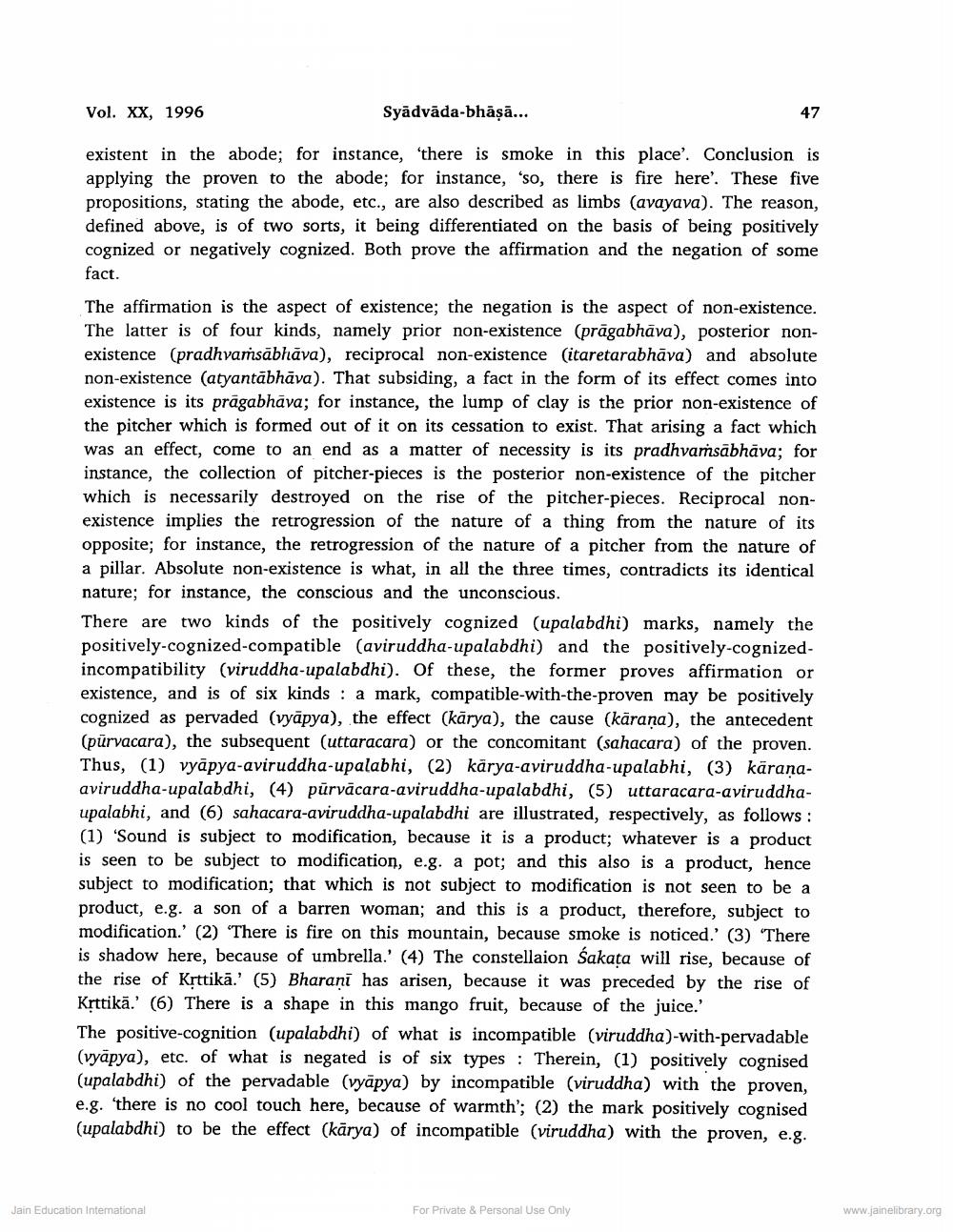________________
Vol. XX, 1996
Syadvāda-bhāṣā...
existent in the abode; for instance, there is smoke in this place'. Conclusion is applying the proven to the abode; for instance, 'so, there is fire here'. These five propositions, stating the abode, etc., are also described as limbs (avayava). The reason, defined above, is of two sorts, it being differentiated on the basis of being positively cognized or negatively cognized. Both prove the affirmation and the negation of some fact. The affirmation is the aspect of existence; the negation is the aspect of non-existence. The latter is of four kinds, namely prior non-existence (prāgabhāva), posterior nonexistence (pradhvaṁsābhāva), reciprocal non-existence (itaretarabhāva) and absolute non-existence (atyantābhāva). That subsiding, a fact in the form of its effect comes into existence is its prāgabhāva; for instance, the lump of clay is the prior non-existence of the pitcher which is formed out of it on its cessation to exist. That arising a fact which was an effect, come to an end as a matter of necessity is its pradhvaṁsābhāva; for instance, the collection of pitcher-pieces is the posterior non-existence of the pitcher which is necessarily destroyed on the rise of the pitcher-pieces. Reciprocal nonexistence implies the retrogression of the nature of a thing from the nature of its opposite; for instance, the retrogression of the nature of a pitcher from the nature of a pillar. Absolute non-existence is what, in all the three times, contradicts its identical nature; for instance, the conscious and the unconscious. There are two kinds of the positively cognized (upalabdhi) marks, namely the positively-cognized-compatible (aviruddha-upalabdhi) and the positively-cognizedincompatibility (viruddha-upalabdhi). Of these, the former proves affirmation or existence, and is of six kinds : a mark, compatible-with-the-proven may be positively cognized as pervaded (vyāpya), the effect (kārya), the cause (kārana), the antecedent (pūrvacara), the subsequent (uttaracara) or the concomitant (sahacara) of the proven. Thus, (1) vyāpya-aviruddha-upalabhi, (2) kärya-aviruddha-upalabhi, (3) karanaaviruddha-upalabdhi, (4) purvācara-aviruddha-upalabdhi, (5) uttaracara-aviruddhaupalabhi, and (6) sahacara-aviruddha-upalabdhi are illustrated, respectively, as follows: (1) 'Sound is subject to modification, because it is a product; whatever is a product is seen to be subject to modification, e.g. a pot; and this also is a product, hence subject to modification; that which is not subject to modification is not seen to be a product, e.g. a son of a barren woman; and this is a product, therefore, subject to modification.' (2) 'There is fire on this mountain, because smoke is noticed.' (3) 'There is shadow here, because of umbrella.' (4) The constellaion Sakata will rise, because of the rise of Krttikā.' (5) Bharani has arisen, because it was preceded by the rise of Krttikā.' (6) There is a shape in this mango fruit, because of the juice. The positive-cognition (upalabdhi) of what is incompatible (viruddha)-with-pervadable (vyäpya), etc. of what is negated is of six types : Therein, (1) positively cognised (upalabdhi) of the pervadable (vyāpya) by incompatible (viruddha) with the proven, e.g. 'there is no cool touch here, because of warmth'; (2) the mark positively cognised (upalabdhi) to be the effect (kārya) of incompatible (viruddha) with the proven, e.g.
Jain Education Intemational
For Private & Personal Use Only
www.jainelibrary.org




